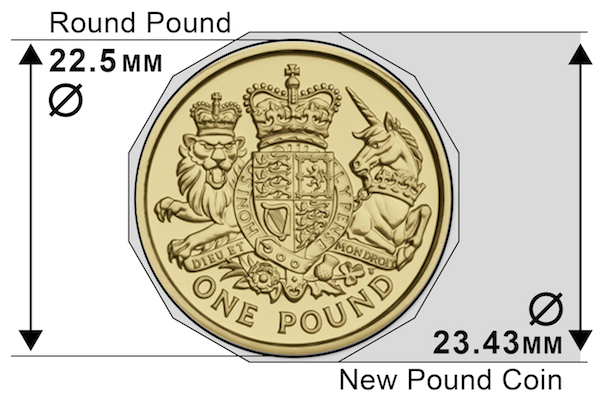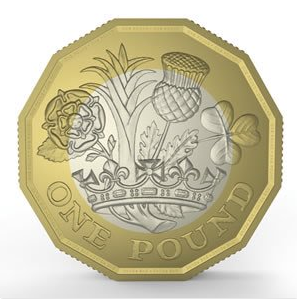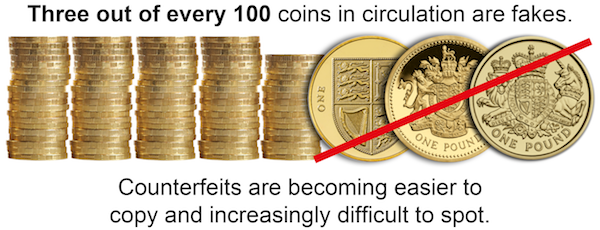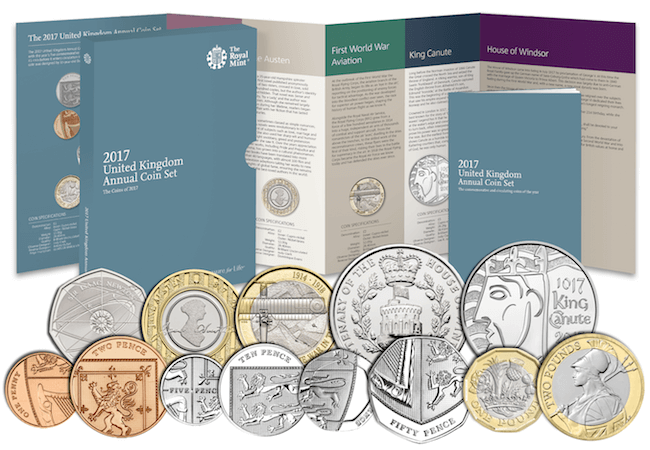Posts Tagged ‘Security’
The New 12-sided £1 Coin: All the facts
It has been confirmed that the new 12-sided £1 coin will enter circulation in less than 12 weeks time.
28th March 2017 is sure to become a historic day as we welcome the new coin which has been billed to become the most secure circulating coin in the world.
This will be the first specification change to our £1 coin in more than 3 decades, since the pound was first introduced in 1983.
What’s new?
Formally named ‘The Nations of the Crown 2017 UK £1‘ the coin was designed by 15-year-old David Pearce following a public competition in 2015. The new design is made up of the English rose, the Welsh leek, the Scottish thistle and the Northern Irish shamrock emerging from one stem within a royal coronet to represent the four constituent countries of the United Kingdom.
Important dates:
28th March 2017: The new 12-sided £1 coin will enter circulation. It may take a little while for people to start seeing it in their change as it gradually filters into general use.
28th March – 15th October 2017: During these six months the co-circulation period will take place. You will be able to use both coins as normal in this time in preparation for demonetisation.
16th October 2017: The Round £1 will cease to be legal tender from this day onwards.
We’re really looking forward to finding them in our change when they’re released in 83 days time. And remember, pound coins with the 2017 date are likely to be more sought after – especially in good condition or uncirculated.
Be one of the FIRST people to own the new £1 Coin.
Today you can own all 13 of the United Kingdom’s 2017 coins including the brand new ‘Nations of the Crown’ 12-sided £1 within the latest annual coin pack.
Everything you need to know about the new 12-sided £1 coin
What coin is changing, and when?
The Royal Mint is issuing a 12-sided £1 coin resembling the old three-penny bit which will enter circulation in March, 2017.
At the moment there are no other plans to change any other circulating coins but Her Majesty’s Treasury and The Royal Mint keep the specifications and denominational mix of UK circulating coins under continual review.
How will the new coin change?
The new £1 coin will feature 12 sides and is billed to become the most secure circulating coin in the world.
They will feature added security features including:
- 12 sides – A non-round design makes it harder to copy, and is already used in our 50p and 20p coins, as well as in coins abroad.
- Two metals – The outside will be nickel-brass, and the inside nickel-plated solid alloy. The Government believes this combination of two metals PLUS 12 sides will be the killer security feature.
- Hidden messages – The nickel plating is especially designed to be hard for forgers to remove and iSIS plated coins can include secret electromagnetic signatures.
- A bigger diameter – The new £1 will be just slightly bigger, at 23.43mm from point to point. The 12 sides means its diameter will also be uneven.
- Milled edges – The new £1 coin will have milled edges – grooves in the side of the coin as well as an edge inscription.
- Secret Images – Known as latent images, these are pictures etched into the metal that only become visible when tipped in the light.
What size will the new pound coin be?
The current round £1 coin is 22.5mm in diameter. The new 12-sided £1 coin will be just slightly bigger, at 23.43mm from point to point. The 12 sides means its diameter will also be uneven.

What design will appear on the new coin?

The 12-sided £1 coin will feature a rose, leek, thistle and shamrock emerging from a royal coronet.
The coin has been designed by schoolboy David Pearce which was picked after a public competition and has been adapted by professional artist David Lawrence.
What will happen to my old £1 coin?
The round pound coins will start to be withdrawn from circulation as the 12-sided coins are introduced. Following the six-month co-circulation period, legal tender status of the existing £1 will be withdrawn.
What happens if I still have old pound coins after legal tender status has been withdrawn?
After the six month co-circulation period, round £1 coins will no longer be able to be used as payment and will cease to be legal tender.
Will I be able to use the coin in the same way?
Yes. The 12-sided pound coins can be used in the same way as the current pounds. For example, they will be available from banks and can be used in self-service checkout tills and parking payment machines. Rigorous rolling tests have been carried out to ensure they will work in vending machines.
Why bother changing it?
One Pound coins were first issued in 1983, but one in every thirty £1 coins is now a fake. These forgeries cost the Government £2million every year.

The new 12-sided £1 coin will be an ultra-secure replacement which will be harder for forgers to copy. They will also last 5 years longer than the current round pound coins.
Will they be collectable?
Like any new issues, collectors will be keen to own the very first design of any new coin. Pound coins with the 2017 date are likely to be more sought after – especially in good condition or uncirculated.
Germany’s first ever 5-euro coin has been released into circulation… and it’s see-through!
Germany’s first ever 5-euro coin was released into circulation yesterday. Dubbed the ‘three material coin‘, it is also see-through!
New 'see-through’ five-Euro coin unveiled in Munich. https://t.co/4UTYBLKHcQ pic.twitter.com/X57uOFIn3t
— The Local Germany (@TheLocalGermany) April 12, 2016
Developed by Dr Peter Huber and Günther Waadt, the coin features a blue plastic ring in the middle and has been named ‘Blue Planet Earth’.
Not only is the blue ring easy to identify and authenticate by the naked eye, it is made of polymer plastic which behaves like a form of insulation between the pieces of two different metals and will be easy for cash machine to recognize whether it is real or fake.
A first in the history of coins
A German Minting Technology team has spent a decade developing this new security feature. In fact, it’s the first coin to be made from a combination of metal and plastic materials.
The plastic ring can be manufactured in any colour – perhaps we’ll see a rainbow of coloured Euro coins in the near future! It is also rumoured that the coin can change colour when exposed to UV light.
A total of 2 million coins have been released and will undoubtedly be snapped up and highly prized by coin collectors… if they haven’t already.
Yesterday it was reported that hundreds of Germans were queuing at the Bundesbank in Frankfurt for a chance to get hold of this new cutting-edge coin.
It’s unlikely that these 5-euro coins will be used in everyday transactions but if you are lucky enough to be heading to Germany any time soon, make sure you keep a look out.

